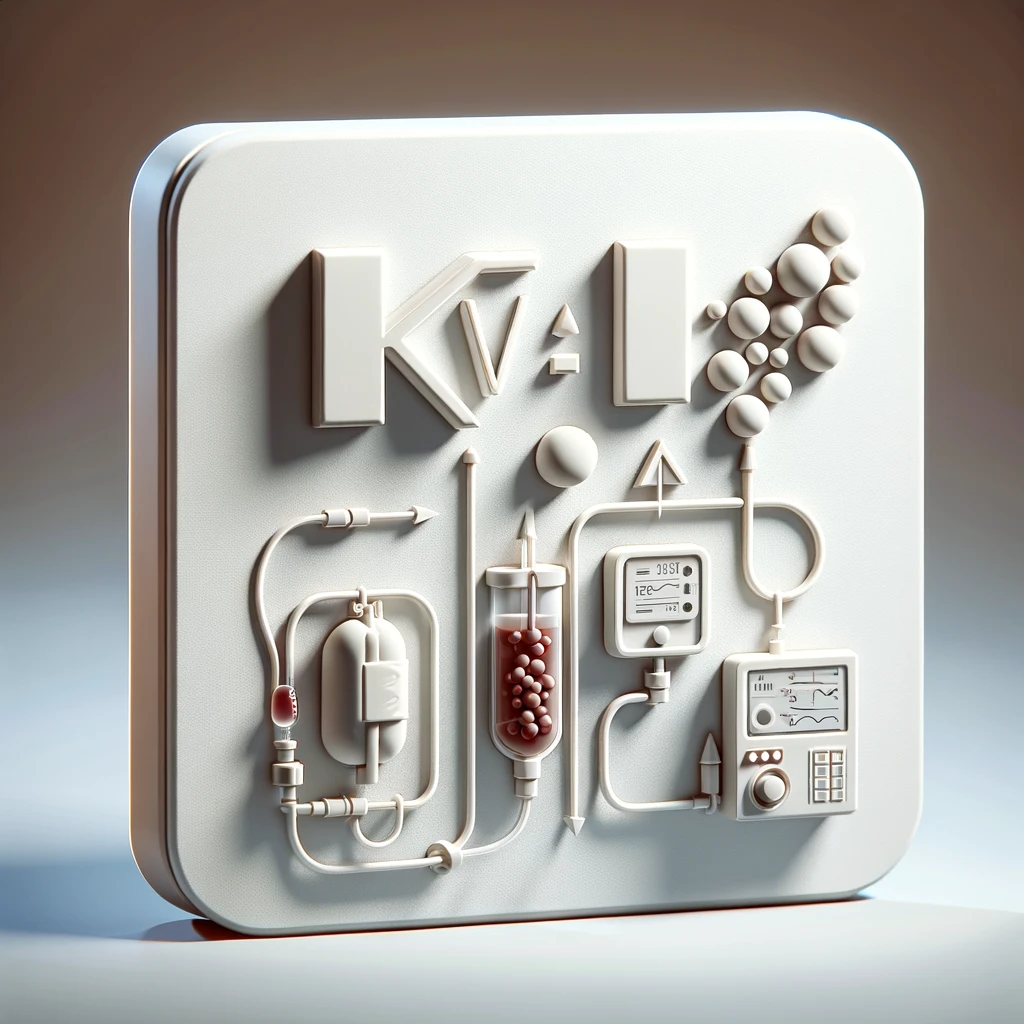
Kt/V is a widely used parameter for quantifying the adequacy of dialysis treatment in patients with end-stage renal disease (ESRD). It is a dimensionless number that reflects the efficiency of dialysis in clearing urea from the blood.
The term Kt/V (pronounced K T over V) integrates 3 critical factors:
K (Clearance): The clearance of urea (K) is typically measured in milliliters per minute (mL/min). It represents the volume of blood that is completely cleared of urea per unit time by the dialyzer.
t (Time): The duration of the dialysis session (t) is measured in minutes (min). It represents the total time over which dialysis is performed during a session.
V (Volume of Distribution): The volume of distribution of urea (V) is generally estimated in liters and entered in the formual as mililiters (mL). This value approximates the total body water in the patient, which is the volume in which urea is distributed.
When calculating Kt/V, it is essential to ensure that the units are consistent to produce a dimensionless number.
Significance of Kt/V
Kt/V serves as a key indicator of dialysis adequacy, providing a measure to ensure that patients receive sufficient dialysis to remove uremic toxins and prevent complications associated with underdialysis.
Adequate dialysis is essential to improve survival rates, reduce morbidity, and enhance the quality of life for ESRD patients. A higher Kt/V value generally indicates better clearance of urea and other waste products, suggesting more effective dialysis.
Guidelines from organizations such as the Kidney Disease Outcomes Quality Initiative (KDOQI) recommend target Kt/V values to guide clinical practice.
Methodology of Kt/V Measurement
There are several methods to measure Kt/V, with the most common being single-pool (spKt/V) and double-pool (eKt/V) models. Each method varies in complexity and the precision of the clearance measurement.
Single-pool Kt/V (spKt/V)
Single-pool Kt/V is calculated using pre- and post-dialysis blood urea nitrogen (BUN) levels. The formula is:
Kt/V = − ln(Cpost/Cpre − 0.008 × t) + (4 − 3.5 × Cpost/Cpre) × (UF/V)
where:
Cpost is the post-dialysis BUN
Cpre is the pre-dialysis BUN
t is the dialysis session length in hours
UF is the ultrafiltration volume, and
V is the volume of distribution of urea.
This method assumes a single, uniform compartment for urea distribution, simplifying the calculation but potentially underestimating the urea removal in cases of significant fluid shifts.
Equilibrated Kt/V (eKt/V)
Equilibrated Kt/V accounts for the rebound increase in BUN that occurs after dialysis, providing a more accurate measure of urea clearance. It is calculated using the Daugirdas II formula, which adjusts for the post-dialysis rebound:
eKt/V = spKt / V − (0.6 × spKt / V)
This adjustment acknowledges that urea levels do not instantaneously equilibrate between the blood and tissue compartments at the end of dialysis.
Implications of Kt/V Values
Kt/V values have significant implications for patient management. A Kt/V value of 1.2 to 1.4 per dialysis session is typically recommended for thrice-weekly hemodialysis.
Values below this range indicate inadequate dialysis, necessitating adjustments in treatment parameters such as increased dialysis duration, frequency, or dialyzer efficiency. Conversely, excessively high Kt/V values, while rare, may indicate overly aggressive dialysis, which can also pose risks such as hypotension and rapid shifts in fluid and electrolyte balance.
Inadequate dialysis, reflected by low Kt/V values, is associated with higher morbidity and mortality, increased hospitalizations, and poor quality of life. Therefore, regular monitoring of Kt/V is crucial in optimizing dialysis prescriptions to achieve target values and improve clinical outcomes.
Conclusion
Measuring Kt/V is fundamental in assessing and ensuring the adequacy of dialysis treatment for ESRD patients. By integrating the clearance rate, dialysis duration, and patient-specific factors, Kt/V provides a comprehensive metric for evaluating dialysis efficiency.
Quiz
Please note that our articles are not intended to guide personal health decisions.
This content has been curated by Renes Care. Unauthorized use or reproduction is prohibited.
© Renes Care. All rights reserved.
